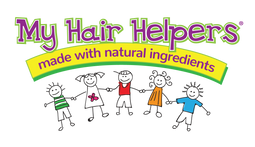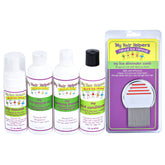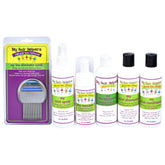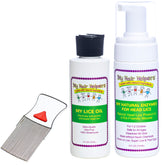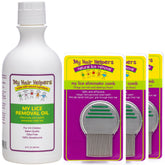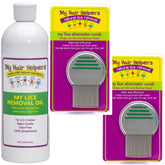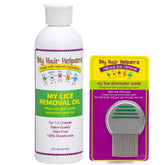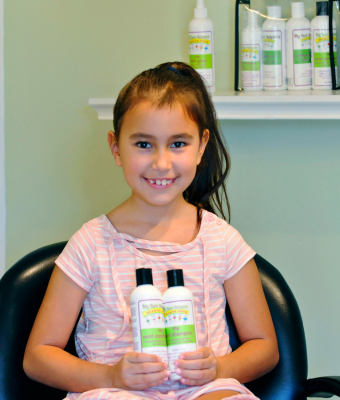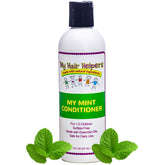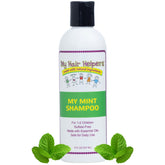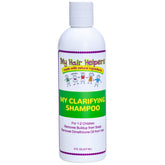WHAT IS THE DIFFERENCE BETWEEN NITS, EGGS, AND LICE?

When dealing with a head lice infestation, you might hear a variety of terms such as “nits,” “eggs,” and “lice” being used interchangeably. While all of these terms are connected to the head lice life cycle, they refer to different stages of the insect’s development.
Understanding the difference between nits, eggs, and lice is essential for effective management. If you suspect that your child has head lice, or you know that there is an outbreak going around their school or daycare, it’s helpful to know what to watch for.
Let’s break down the distinctions between these terms and explain how to identify and address each stage of a lice infestation.
What Are Nits?
Nits are the tiny, oval-shaped eggs laid by adult lice. They are typically yellow, white, or tan in color and are attached firmly to the hair shaft near the scalp. Nits are so small that they are often mistaken for dandruff, but unlike dandruff, they are difficult to remove because they are stuck to the hair with a sticky substance produced by the female louse.
Nits are not yet hatched, so they do not move or cause the itching sensation that is commonly associated with lice. However, they are the first stage of the lice life cycle, and each nit has the potential to become a live louse, so it’s essential to remove them to prevent further infestation.
Key Characteristics of Nits
Small, oval-shaped Firmly attached to hair near the scalp Tan, white, or yellowish in color Difficult to remove without a nit comb
What Are Lice Eggs?
Lice eggs are essentially the same as nits, but the term “lice eggs” can sometimes refer to two stages: unhatched and hatched eggs. When people refer to "eggs," they may mean either nits (unhatched) or the empty shells left behind after a louse has hatched.
After a louse hatches, the remaining egg shell stays attached to the hair shaft and is called a “nit shell” or “empty nit.” Hatched eggs, or empty nits, are typically translucent or white in color and are often found farther down the hair shaft as the hair grows out. These empty nit shells need to be removed to ensure complete lice eradication, as they can sometimes be mistaken for live nits.
Key Characteristics of Lice Eggs:
- Can be either unhatched (live nits) or hatched (empty nits)
- Empty nits are translucent or white
- Usually found attached to the hair near the scalp or further down as the hair grows
- Require manual removal with a fine-tooth nit comb
What Are Lice?
Lice are the adult stage of the insect’s life cycle. They are tiny, wingless parasites that live on the scalp and feed on human blood. Adult lice are about the size of a sesame seed and are tan, gray, or white in color, making them difficult to spot, especially on lighter hair.
Unlike nits or eggs, lice can move quickly, which makes them harder to detect. Lice cannot fly or jump; they crawl from one host to another through direct head-to-head contact or by sharing personal items like hats, combs, or bedding.
Adult lice live for about 30 days, during which time they can lay up to six eggs per day. Without intervention, an infestation can quickly worsen as new lice hatch and mature.
Key Characteristics of Lice:
- Small, wingless insects about the size of a sesame seed
- Tan, gray, or white in color Live on the scalp and feed on blood
- Can move quickly but cannot fly or jump
- Cause itching due to bites
The Lice Life Cycle
To fully understand the difference between nits, eggs, and lice, it helps to look at the life cycle of the head louse:
- Nits (Eggs): The female louse lays eggs (nits) close to the scalp. These eggs are attached firmly to the hair shaft.
- Nymphs (Young Lice): After 7 to 10 days, the nits hatch into nymphs. Nymphs are baby lice that are smaller than adult lice but feed on the scalp just like adults.
- Adult Lice: Nymphs mature into adult lice in about 7 to 10 days. Once mature, adult lice can lay more eggs, continuing the cycle if left untreated.
Each stage of this life cycle requires specialized attention.
How to Manage Nits, Eggs, and Lice With My Hair Helpers
Effective management involves targeting both live lice and the nits to prevent reinfestation. Here’s how to approach this:
Slow Down Lice
Using My Lice Oil or My Cocomint Oil to massage and saturate the head. This process slows down bugs making them easier to remove. Unlike over-the-counter products that contain permethrin or pyrethrin, our lice oil uses dimethicone, an FDA-approved product safe for human use and with a low risk for adverse effects.
Remove Knots and Tangles
It’s recommended to apply conditioner to the hair because this softens it up and makes it easier to manage. Add a few drops of our mint conditioner to a spray bottle, mix it up with some warm water, and you have a great smelling spray conditioner to use on your child’s hair. This also prevents missing any lice or nits that may be stuck in those tangles.
Loosen Nit Glue
One of our most unique products are our natural enzymes to loosen nit glue in a kid-friendly mousse formula. Nits are difficult to remove because of this glue, but our product dissolves it without using harsh ingredients or chemicals.
Comb Through Hair
A fine-tooth nit comb is one of the most reliable ways to remove nits and lice. This comb is designed to catch and remove even the smallest nits and eggs from the hair. Comb through wet hair in small sections to ensure you capture as many lice and nits as possible. Repeat this process every few days for two weeks to ensure complete removal.
Safeguard Against Lice
Once you apply our products to your child’s hair, you want to make sure that they stay lice-free! Fortunately, this is made easy with our lice defense products. You can use these products daily—they smell great, are made from natural ingredients, and will deter head lice from choosing your child’s head as their new habitat!
Conclusion
Understanding the differences between nits, eggs, and lice is crucial for effectively managing a lice infestation. While nits are the eggs of lice, lice are the adult insects that cause the itching and irritation associated with an infestation.
To fully rid your home and family of lice, you must target all stages of the life cycle, using both manual removal and appropriate products. Fortunately, you have My Hair Helpers to help you on this journey!
